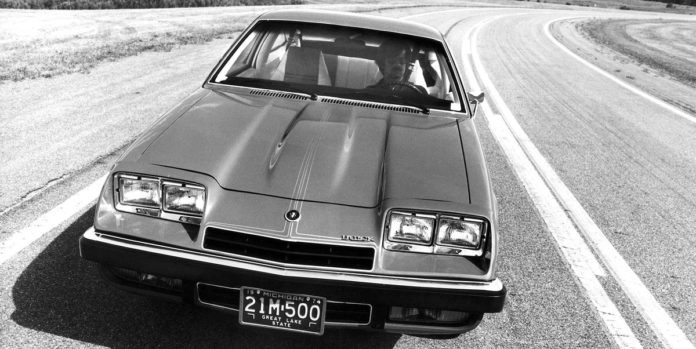From the April 1975 issue of Car and Driver.
In what has to rank as one of the grandest recycling projects ever conceived, Buick has retrieved a set of discarded tooling to come up with a “new” engine for 1975. It’s the old familiar V-6, originally designed to cut the unfortunate warranty costs being amassed by the aluminum V-8 in the 1962 Buick Special. As the Special grew up, however, the small, shaky 90-degree V-6 no longer fit the car’s character, so it was retired from service. Willys-Jeep then stepped in to make Buick Division an offer it couldn’t refuse for the obsolete tooling and put the engine into the 1968 Jeep.
In 1970, AMC absorbed Willys and decided to use its own engine in the veteran workhorse. Again, the tools collected dust until a stopgap marketing decision gave Buick and Oldsmobile a new small car—their own version of the Monza 2+2—for which they had no small engine. In a flash of brilliance, the V-6 tooling was repurchased from AMC, and Buick was back in production with a subcompact engine.
Other than minor trim details, the V-6 is the only feature that distinguishes a Buick Skyhawk or Olds Starfire from a Monza. While there is a 140-cubic inch four or a 262-cu. in. V-8 choice in the Monza, the 231-cu. in. V-6 is the only engine available in either the Skyhawk or the Starfire.
You pay an extra $22 over the price of a Monza with the optional 262 V-8; you get the V-6, a Buick nameplate and virtually the same performance. The Skyhawk and the Monza that Car and Driver tested turned in nearly identical quarter-mile acceleration times and interior noise levels, the exact same stopping distance, and fuel economy within a half mpg of each other. (In the C/D mileage cycle, the Skyhawk delivered 18.5 mpg compared to 18.0 in the Monza.)
Similar personalities are to be expected because both engines are rated at 110 net hp. The Buick’s 175 pound-feet of torque is 25 less than the larger Monza engine’s peak, but that discrepancy is masked by significant weight and gearing differences between the two cars. Buick says the V-6 is lighter than the Chevrolet V-8 by only 25 pounds, but we found our test Monza to be a full 105 pounds heavier than a similarly equipped Skyhawk. And while Chevrolet offers a 2.92-to-one “performance” axle, there is but one choice—the 2.56 gear—for all Skyhawks and Starfires. In addition, Buick has specified significantly higher (lower numerically) gear ratios in the Turbo Hydramatic 350 transmission and a tighter torque convertor as well. So if you choose a Skyhawk over the Monza, you get less torque, less weight, much taller gearing, and almost the same performance.
You do get one extra with the Skyhawk or Starfire: vibration. Engineers would never build a V-6 with a 90-degree block if they had their way. Such an engine needs a 60-degree layout for equal firing intervals. (In a conventional V-8, four cylinders fire every time the crank revolves once; build a V-6 with the same right-angle layout and three cylinders fire, then pause to wait for the nonexistent fourth, every revolution.) But there are tremendous savings to be accomplished by sharing components with 90-degree V-8 blocks. So really, the Skyhawk’s 231 engine is a Buick 350 V-8 with two cylinders missing, a slightly shorter stroke and the same pistons, connecting rods and some external accessories.
The major problem with a 90-degree V-6 is those irregular firing intervals from cylinder to cylinder. This makes the engine feel rough, particularly at idle. The shaking rattles interior furnishings and sets the whole car a-quiver, a vice from which the Monza V-8 does not suffer.
As you ease off idle, the roughness fades and the Skyhawk’s character is then dominated by its incredibly tall gearing. The justification is, of course, fuel economy. At 55 mph, the V-6 is loafing along at a lazy 2100 rpm. An eager downshift in the transmission helps throttle response somewhat, but we found the car to suffer a chronic stumble under acceleration. Through the rev range, the V-6’s spirit is dull, tranquilized by emissions control and the catalytic converter through which it has to breathe. The best way to pump some life into the Skyhawk is to avoid the automatic transmission and order the new optional four-speed manual gearbox.
The Skyhawk is struggling to establish an identity of its own—with its V-6 engine, it at least has a good start.
Specifications
Specifications
Year Make Model Trim
Vehicle Type: front-engine, rear-wheel-drive, 4-passenger, 2-door hatchback
PRICE
Base/As Tested: $4186/$5142
Options: automatic transmission, $237; power steering, $111; air conditioning, $398; tilt steering column, $45; AM radio, $63; tinted windshield, $29; adjustable seat back, $16; deluxe wheel covers, $36; protective body side moldings, $21
ENGINE
pushrod V-6, iron block and heads
Displacement: 231 in3, 3788 cm3
Power: 110 hp @ 4000 rpm
Torque: 175 lb-ft @ 2000 rpm
TRANSMISSION
3-speed automatic
CHASSIS
Suspension, F/R: control arms/rigid axle
Brakes, F/R: 9.9-in disc/9.0-in drum
Tires: Goodyear Steel Belted Radial BR78-13
DIMENSIONS
Wheelbase: 97.0 in
Length: 179.3 in
Width: 65.4 in
Height: 50.2 in
Curb Weight: 3105 lb
C/D TEST RESULTS
30 mph: 4.1 sec
60 mph: 11.3 sec
1/4-Mile: 18.6 sec @ 76 mph
90 mph: 32.2 sec
Top Speed (observed): 106 mph
Braking, 70–0 mph: 192 ft
Roadholding: 0.85 g
C/D FUEL ECONOMY
Observed: 17–22 mpg
C/D TESTING EXPLAINED

